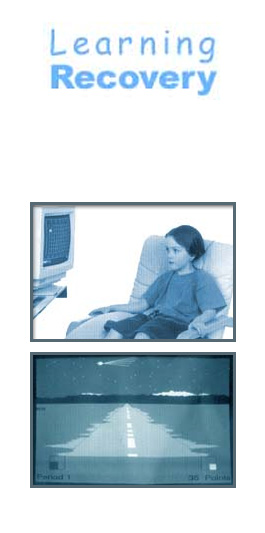DEDICATED TO RESTORING ABILITY
TO PROCESS INFORMATION
SERVICES
Neurofeedback
WHAT IS NEUROFEEDBACK?
Every thought, feeling and action has an underlying brain wave pattern. Normal patterns of attention, arousal and well-being are created and maintained at deep physiological levels. Due to stress, genetics, trauma, drug or chemical exposure these patterns can get disregulated. This limits development and may result in the establishment of self-limiting attitudes and patterns of behavior. Cognitive and linguistic abilities can be affected as much as emotional development. However neurofeedback can help the individual to learn and maintain more efficient attention and response patterns. Life becomes simpler, easier, less effortful and stressful when the brain is working optimally. Productivity and creativity is stimulated and the individual can reach levels of peak performance.
HOW DOES IT WORK?
Neurofeedback in Stress, Depression, Insomnia and Mood Swings
Neurofeedback is is particularly efficient in regulating mood disorders caused by the
stresses and losses of daily living. It helps the client recognise and control the
brainwaves that cause the negative feelings. Thus it is a fundamentally different
principle to medication, which is a crutch rather than a cure.
Sensors are placed on the "trainee's" scalp and on each ear. Brainwaves are monitored by a computer and goals are set that require the trainee to voluntarily produce more beneficial brainwave patterns. A second linked computer "coaches" the trainee by presenting visual, auditory and tactile representations of the trainee's brainwave signals in a video game format. This process is called feedback because it informs the trainee about his or her momentary success in making the desired brain changes. As the trainee exercises this ability to voluntarily change brain activity, new and beneficial response patterns are created. Practised over an average of 20 to 40 sessions, these new modes of behaviour are well learned, becoming natural responses available whenever needed.
NEUROFEEDBACK IN EDUCATION
Neurofeedback is becoming part of the special needs equipment in American schools. Helping Dyslexic, Dyspraxic, Dysgraphic, Dyscalculic, Autistic and Attention Deficit children, among others. All specific learning difficulties have a similar underlying brainwave problem that affects either linguistic, motor, concentration or emotional output. The academic consequences are seen in reading, spelling, writing, listening, attention and motivation problems in the classroom; lack of co-ordination on the sports field or playground or social interaction in general.
READING
Involves a complex interaction throughout the left hemisphere, aspects of the right, and sub-cortical areas, all contributing differently to reading and spelling. These sub-components of reading need to be in precise, interlocking harmony before a word is recognized. Neurofeedback can help integrate these.
WRITING
when links from the auditory areas to the visual are weak, it is difficult to put thoughts into written (visual) form - this circuit can be stimulated by neurofeedback.
NUMERACY
Holding sequences in mind in order to manipulate them is necessary in both reading and arithmetic. This aspect of working memory can also be enhanced by neurofeedback.
MOTOR SKILLS
The integration of the senses with the motor area so that output is smoothly matched by input can help the clumsy, uncoordinated child.
THE HISTORY OF MENTAL FITNESS TRAINING
The EEG Spectrum Mental Fitness Training Programme began in 1985, based on more than 20 years research by Professor Barry Sterman, Ph.D. He has published over 160 scientific papers which clearly indicate that, with the assistance of Brainwave training or neurofeedback, the brain is capable of learning and maintaining new, more beneficial response patterns even in the face of severe functional deficits.
Excited by the potential of neurofeedback for their own son, scientists Siegfried and Sue Othmer made a commitment to bring this technique out of the laboratory and into public use. EEG spectrum opened it's first clinic in Encino, California in 1989.
A comprehensive training course followed and now there are over 1,500 professionals using EEG techniques in the USA with over 300 affiliated centres in Europe, Australia, South Africa and New Zealand. EEG Spectrum promotes all aspects of the neurofeedback field, providing training for professionals in medical, educational and psychological fields.
Neurofeedback can contribute to the resolution of some of the most intractable problems in our society: the problems of addiction, impulsive and violent behaviour, mood disorders, the mental decline of the elderly and the learning and behavioural difficulties of children. It has also proven itself powerfully in clearing and focusing the brain for peak performance.
Expanding the potential of this exciting new approach will likely be one of the major thrusts in the filed of mental health in the 21st century.
A readable history is in "Symphony in the Brain" by Jim Robbins.
Dr Beverley Steffert is the U.K. affiliate for EEG Spectrum and uses their software and training methods to provide a neurofeedback service tailored to ameliorate specific learning difficulties, addiction and behaviour problems as well as promoting creativity and reducing stress.
Learning Recovery is Affiliated with EEG Spectrum International and this Web site is a useful resource, so have a look.
Service Categories
Counselling, Psychotherapy
|
|
 |